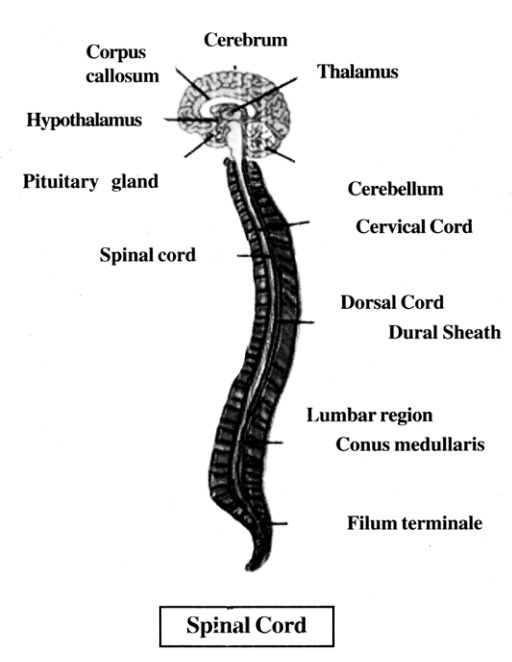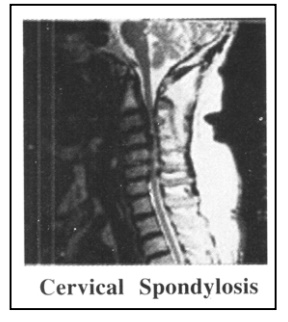Chapter: Diseases of The Brain and Nervous System(A Health Education Guide): Diseases of the Spinal Cord : Myelopathy
Diseases of the Spinal Cord - Myelopathy
Diseases of the Spinal Cord – Myelopathy
Till now we have discussed about the diseases related to the brain. Now before going ahead with the diseases of.the nerves and the muscular system, we will discuss the diseases of the spinal cord in brief.

The spinal cord is the relay station of the messages going in and out of the brain to and fro from the nerves and muscles. Encased safely within the veraebrae of the vertebral column the spinal cord is a very important organ of the nervous system. There are over 30 types of diseases that can occur in the spinal cord which can be understood in terms of the working and the structure of the spinal cord, its function of carrying the messages, its length, its cylindrical shape, its small width, its membranes, its blood vessels, its relation with the vertebrae etc....
Symptoms of the diseases of the spinal cord :
· lWeakness or paralysis of the lower limbs.lTingling sensation in the entire leg.
· L Weakness in all the four limbs.
· Retention of urine and\or stool or loss of bladder or bowel control.
· Continuous pain in any part of the hands or legs.
· The patient may remain unaware even if his footwear comes off (loss of sensation) or a feeling of cushioning of the feet, burning sensation, sensation of ants crawling over the legs or hands.
· The wasting of the muscles of hands and legs, etc.
The symptoms of spinal cord diseases are mainly seen as a syndrome and are very obvious, hence the diagnosis is usually clear. These diseases are known as Myelopathy.
If there is damage in the part of the spinal cord situated between the cervical vereabrae, it is known as cervicalmyelopathy in which the normal movements as well as thesensations of the legs and hands get hampered. If there isany damage to the part of the spinal cord situated between the thoracic vereabra, only the movement and sensations of one or both of the legs are affected. There may be problems in bowel and bladder movements. This is known as DorsalMyelopathy.
Important Points :
a) The spinal cord is usually not found in the lumbar vertebrae, that is, the spinal cord ends at the first lumbar L1 vertebra. This is known as conusmedullaris. From here it gets transformed into the nerves known as CaudaEquina (like the tail of a horse).
b) In the diseases affecting only the spinal cord, there are no symptoms related to the brain like speech defects, ability to understand, sensations of eyes, ears, nose, seizures, one sided paralysis or facial paralysis, etc. If the above-mentioned symptoms are present, the disease is of some other origin and not purely of spinal cord.
c) Syndromes (symptom complex) of spinal cord disorders :
i. All the sensation in the spinal cord being cut off below a certain level, with loss of movements of both legs, retention of stool and urine may occur e.g. a vertebralfracture in a road accident.
ii. The working of certain sensory nerves gets disturbed and its motor functioning decreases along with pain in the nerve. (Myelo-Radiculopathy) like spondylosis.
iii. The functioning of the half side of the spinal cord is affected. (Brown Sequard). This causes loss of movement of the leg on one side, while the sensation of the other leg gets hampered.
iv. The front part of the spinal cord stops functioning below a level suddenly (e.g. clot in a blood vessel).
v. Compression of the uppermost part of the spinal cord.(Foramen Magnum Compression).
vi. Syringomyelia: The middle portion of the spinal cord becomes hollow and fills with fluid resulting in the atrophy of the nerves of the hands with bladder dysfunction.
vii. ConusMedullaris syndrome: A tumor or compression at the lowermost part of the spinal cord. i.e. L1
viii. CaudaEquina Syndrome: The disease of the group of nerves coming out from the end of spinal cord.
Thus, the spinal cord diseases can be simply divided into two parts :
1. Compressive Myelopathy: Diseases caused by the pressure on the spinal cord due to a tumor, pus, fracture etc.
2. The diseases not caused by the pressure on the spinal cord (Noncompressive Myelopathy): which includes infection in the spinal cord, vitamin deficiency, edema, degeneration, ill effects of chemicals, medicines etc.
3. In such cases MRI, myelography, lumbar puncture etc. can help for accurate diagnosis.

Now let’s discuss the compression of the spinal cord.
1. The diseases, in which there is a tumor or accumulation of fluid in the center of the spinal cord, are called intramedullary diseases of the spinal cord, which can be detected quickly with the help of neurological examination and can be confirmed through MRI.
2. The tumor of the membranes of the spinal cord (Meningioma) or the tumor of the nerves coming out of the spinal cord (Schwannoma).
3. Cancer of the membranes of the spinal cord or lymphoma.
4. Tumor of the external membranes of the spinal cord.
5. Fracture of vertebras, bone tumor, cervical spondylosis, abscess in the vertebra e.g. TB, dislocation of vertebral disc, degeneration of the cord due to fluorosis.
All these causes put pressure on the spinal cord, which can be seen in the diagram below.
MRI of the Spinal Cord :
Among all these cases, injury to the spinal cord due to vehicle-accidents is very common, and many times the treatment for the same is difficult. Symptoms of pressure on the spinal cord and the nerves due to cervical spondylosis are also common, in which surgery may also be required. It is mostly found in adults.

Cervical Spondylosis :
With aging, degenerative change occurs in the bones of the vertebral column.’ This results in an inflammatory process. This process results in osteophyte (tags of bones) formation. Degenerative changes occur in the disc between two vertebrae. The gelatin in the disc oozes outwhich in turn causes compression over the spinal cord leading to various complex symptoms.
If the spinal cord is directly compressed, it is known as myelopathy. Cervical spondylosis is now common. Compression over the C 5-6 or C 4-5 segments results in cervical myelopathy. Similarly dosal myelopathy may occur.

If the nerve roots or nerves are compressed, it may lead to radioculopathy. The patient complains of burning or tingling and, the sensations in the corresponding parts may be decreased (sensory radiculopathy). The muscles supplied by the particular nerves may become weak resulting in difficulty in particular actions (motor radiculopathy).
Spinal cord does not extend in to the lumbar part of spinal canal. Hence, compression in this region affects the nerves resulting in radiculopathy or caudaequina syndrome. In some cases, pain in the neck or back is the only symptom. But this pain can be very distresing.
Appropriate test can give specific diagnosis. The main test is M.R.I. If upon clinical examination, more than onelevel of compression are found, the patient may have to undergo M.R.I. of the whole spine (eg. cervical and lumbar spondylosis coexisting).
As spondylosis mainly occurs due to aging and degenerative changes, it is difficult to check the process. Few tips may be helpful. The patient should avoid moving the neck with a jerk, avoid lifting weight on the head and should wear a cervical collar so as to restrict neck movements.
When the compression over the nerves and spinal cord increases, pain killer drugs, simple exercise or if required tractions are advised. Some experienced doctors use steroids, though very cautiously. In’ appropriate cases, surgery has good results including relief from symptoms of myelopathy and radiculopathy (viz. pain, difficulty in walking).
The rest of the diseases of the spinal cord are known as Noncompressive myelopathy, which can occur due to many reasons. The main causes are as follows:
1. The different types of viral infections of the spinal cord including herpes, rabies and AIDS.
2. Other infectious diseases like TB, fungus, abscess, syphilis, etc.
3. Other inflammations of the spinal cord e.g.
lThe working of the spinal cord can be hamperedby the side effect of the antirabies vaccine
Multiple sclerosis (demylinating disease) • Collagen diseases of spinal cord
Inflammation of the spinal cord caused by malignancy of any other part of the body
l Damage in the spinal cord due to radiationAbove mentioned three conditions are known as Myelitis i.e. inflammation of the spinal cord.
4. Severing of the blood supply to the spinal cord 5: Hemorrhage in the spinal cord, e.g. rupture of an aneurysm
5. Damage to the spinal cord due to deficiency of vitamin B12 or Folic acid
6. Toxic myelopathy caused by the ingestion of toxic foods, drugs or chemicals e.g. Lathyrism caused by eating a particular toxic pulse called masur dal 8.
7. Hereditary degenerative diseases of the spinal cord, e.g familial spastic paraplegia, spino-cerebelar disease etc 9. Degenerative diseases of unknown cause, like the motor neuron diseases
8. Symptoms of damage in the spinal cord due to unknown reasons.
It is not very difficult to diagnose these spinal cord diseases; it’s a kind of calculation. With experience and intuition coupled with, a detailed medical history and efficient neurological reports one can get an accurate diagnosis.
To confirm the diagnosis the main investigations are mentioned below:
· MRI and CT scan of the spinal cord.
· Cerebrospinal fluid examination. 3. Myelography.
· Special laboratory investigations, biochemistry etc.
· If necessary, E.M.G., V.E.P., genetic investigations are also carried out.
Treatment :
A complete diagnosis is very important for necessary treatment. If the disease is due to the compression of the spinal cord, it is important to decide if surgery is possible or not. Surgeries ranging from, long, complicated microsurgery; to the surgeries to dissolve tumors with the help of ultrasound (CUSA) are now available in our country. Surgery of the spinal cord is normally not dangerous, but it is undeniable that the operation has to be done very delicately, skillfully and systematically, because the spinal cord is very narrow and congested with innumerable nerve fibres. Thus, to prevent any damage, the surgeon has to be very cautious during surgery.
The non-compressive disorders are treated according to the underlying cause like:
· Treatment for TB.
· Use of steroids for the treatment of multiple sclerosis and other demyelinating diseases, as well as collagen diseases.
· Vitamin deficiency is treated accordingly.... etc. Specific treatments for congenital diseases or degenerative diseases (like motor neuron disease) have not yet been discovered.
Physiotherapy (exercise) is necessary in all these diseases along with nutritious food. One should also be careful about bedsores. If there are associated bowel and bladder problems they should also be treated simultaneously:
It is not possible to write about all the diseases of spinal cord due to limitation of space, however above information should suffice.
Related Topics